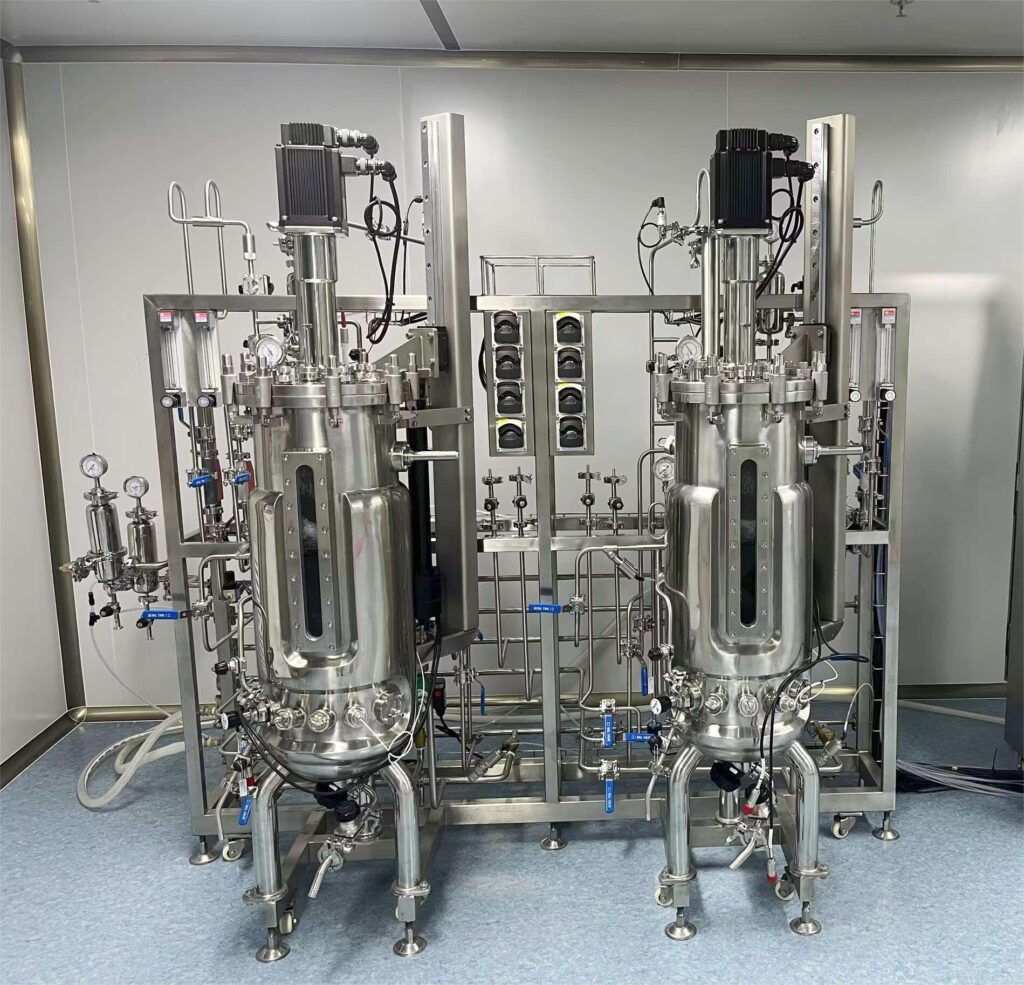
The main functions of stainless steel bioreactors include:
- Providing a good operating environment: Stainless steel bioreactors can provide a stable operating environment such as temperature, pressure and pH value to promote the progress of biological reaction processes. It has a detailed control system that can monitor and adjust the conditions inside the reactor in real time to ensure the best growth and product synthesis conditions.
- Providing sufficient oxygen supply: For biological reaction processes that require oxygen, stainless steel bioreactors can provide sufficient oxygen supply through stirring and gas inlet devices. This oxygen supply method can increase the reaction rate and product yield, and avoid reaction restrictions caused by insufficient oxygen.
- Providing good stirring effect: Stirring is a vital part of the biological reaction process. Stainless steel bioreactors are designed with suitable agitators and stirring structures to evenly distribute the culture medium or substances and ensure that the organisms are fully in contact and mixed with the culture medium to improve the reaction efficiency and product quality.
- Easy operation and cleaning: The stainless steel bioreactor has a closed structure, which can effectively control the flow of materials during the reaction and avoid contamination by external impurities. At the same time, it is also easy to operate and clean, which is convenient for reuse and maintenance.
- Support large-scale production: The stainless steel bioreactor can be expanded as needed to meet large-scale production needs. It can be connected to other equipment and systems to form a complete production line to improve efficiency and production capacity.
Stainless steel bioreactors play a vital role in bioprocessing, providing a good operating environment, sufficient oxygen supply, good stirring effect, convenient operation and cleaning, and large-scale production capacity. These advantages make it a key equipment widely used in biotechnology and pharmaceutical industries.
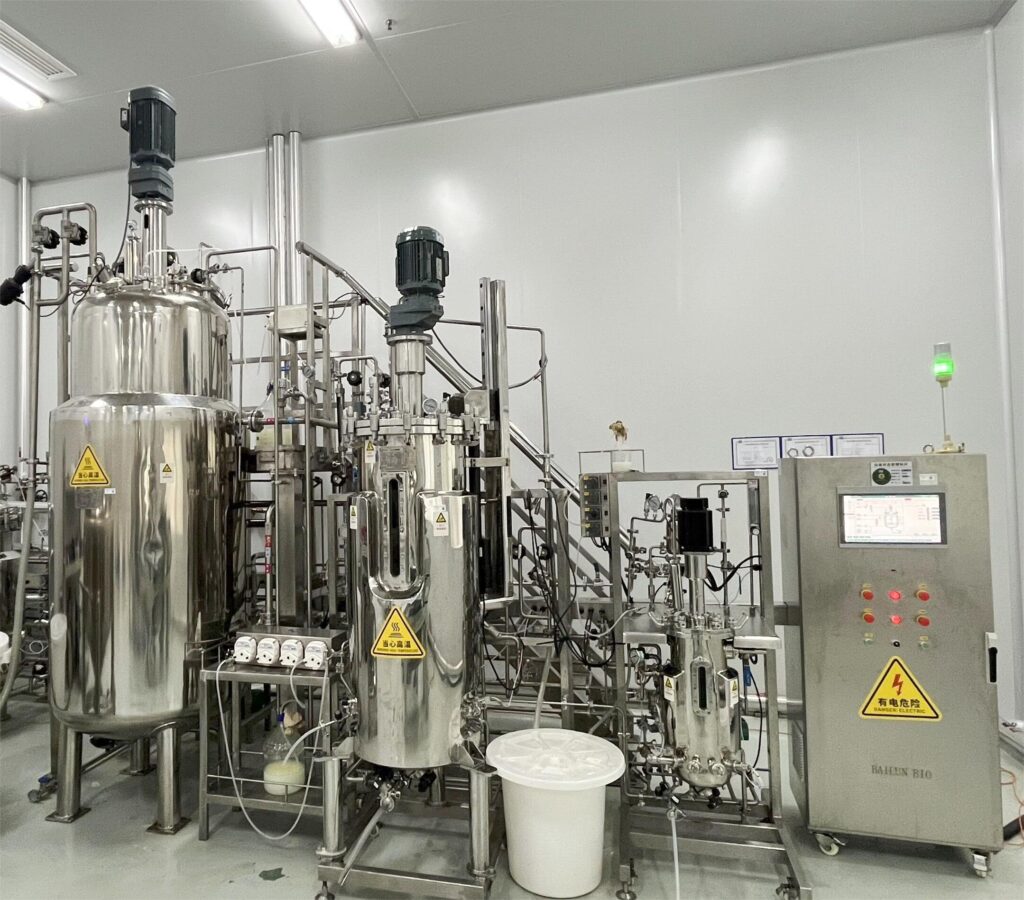
stainless steel bioreactor stirred tank bioreactor
Main components
Stainless steel bioreactors are composed of multiple components, each of which plays an important role to achieve the effective conduct of biological reactions. The following are the main components of stainless steel bioreactors:
- Reactor body: The reactor body is the core component of the stainless steel bioreactor, usually made of stainless steel. It has the characteristics of high strength, corrosion resistance, and high temperature resistance, and can withstand pressure and temperature changes to ensure the safety and stability of the reaction process.
- Stirring system: The stirring system is an important part of the stainless steel bioreactor. It mixes and stirs substances such as culture medium, cells or microorganisms through a stirrer to ensure uniform distribution and full contact of the reaction substances. The stirring system usually consists of a stirrer, a stirring shaft, and a stirring motor.
- Reaction control system: The reaction control system is used to monitor and control important parameters such as temperature, pressure, pH value, dissolved oxygen content, etc. inside the stainless steel bioreactor. It consists of sensors, controllers, and feedback mechanisms, etc., which can monitor the changes in the reaction process in real time and adjust according to the set conditions to ensure the optimal conditions and product quality of the reaction.
- Gas supply system: The gas supply system is used to provide the required oxygen or other gases to the stainless steel bioreactor. It usually consists of a gas inlet, a regulating valve and a gas distribution device, which can control the gas flow and pressure to ensure sufficient and evenly distributed gas supply during the reaction process.
- Temperature regulation system: The temperature regulation system is used to control the temperature of the stainless steel bioreactor to maintain the temperature conditions required for the reaction process. It usually consists of a heating device and a cooling device, etc., which can provide heating or cooling capabilities as needed to regulate the temperature inside the reactor.
- Feed and discharge system: The feed and discharge system is used to add culture medium, nutrients and other reaction materials to the stainless steel bioreactor, and to collect products from the reactor. These systems usually include equipment such as feed pipes, discharge pipes, pumps, etc., which can achieve convenient and safe material transfer.
- Cleaning system: The cleaning system is used to clean and disinfect the stainless steel bioreactor to maintain hygiene and prevent cross contamination. It usually includes equipment such as cleaning nozzles and disinfectant supply systems, which can thoroughly clean and disinfect the reactor.
These components work together to ensure the efficient and safe conduct of biological reactions.
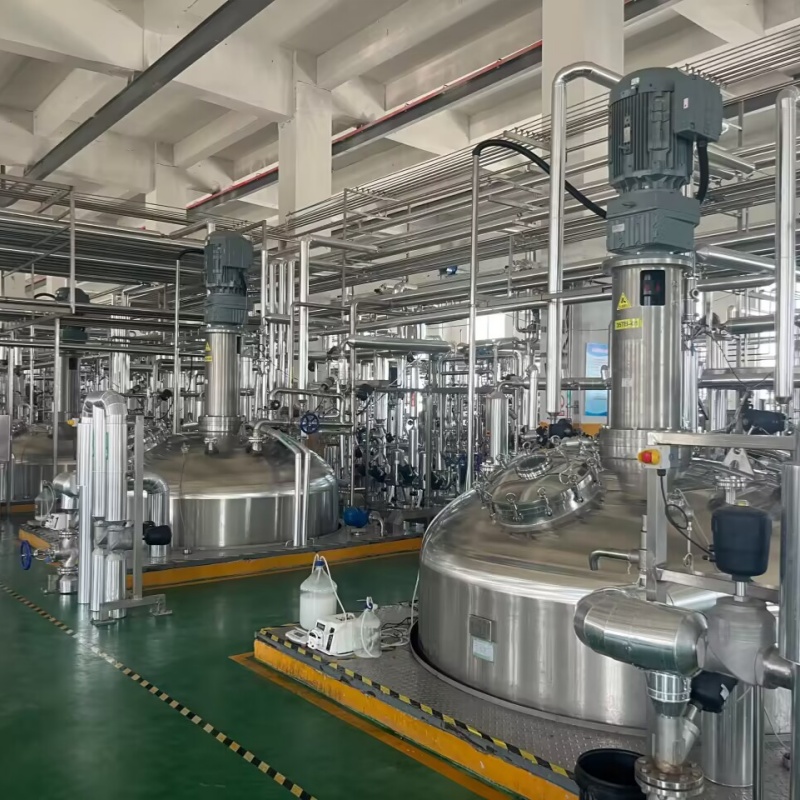
Stainless steel bioreactors can be classified according to different classification standards. The following are some common classification methods:
(1) Classification by scale: According to the size of the reactor, stainless steel bioreactors can be divided into laboratory scale, pilot scale and industrial scale reactors. Laboratory scale reactors are usually used for small-scale research and experiments; pilot scale reactors are used for medium-scale production trials and preliminary process verification; industrial scale reactors are used for large-scale production.
(2) Classification by reaction mode: According to the working mode of the reactor, stainless steel bioreactors can be divided into batch reactors, continuous reactors and semi-continuous reactors. Batch reactors add reactants to the reactor at one time and collect and process them after the reaction is completed; continuous reactors realize the process of continuous addition of reactants and continuous product collection; semi-continuous reactors combine the characteristics of batch and continuous, and realize continuous processing and collection by continuously adding reactants.
(3) Classification by operation mode: According to the operation mode of the reactor, stainless steel bioreactors can be divided into manually operated reactors, semi-automatic reactors and fully automatic reactors. Manually operated reactors require manual control of temperature, stirring speed, pH value, etc. Semi-automatic reactors are assisted by some automated equipment, while fully automatic reactors achieve full automation through computer control systems.
(4) Classification by shape: According to the shape of the reactor, stainless steel bioreactors can be divided into tank reactors, tubular reactors and tower reactors. Tank reactors are the most common form, with a cylindrical shape, usually used for liquid reactions; tubular reactors connect multiple reactor units through pipes for continuous flow reactions; tower reactors are often used for gas phase or solid phase reactions, and have a tower-like shape.
(5) Classification by application field: According to different application fields, stainless steel bioreactors can be divided into cell culture reactors, microbial fermentation reactors, enzyme reactors, etc. Cell culture reactors are used in fields such as cell culture and biopharmaceuticals; microbial fermentation reactors are used for the cultivation of microorganisms and product synthesis; enzyme reactors are specifically used for enzyme-catalyzed reactions.
The above are common classification methods for stainless steel bioreactors. According to specific application requirements and reaction process requirements, choosing a suitable classification and type of stainless steel bioreactor can improve reaction efficiency and quality.
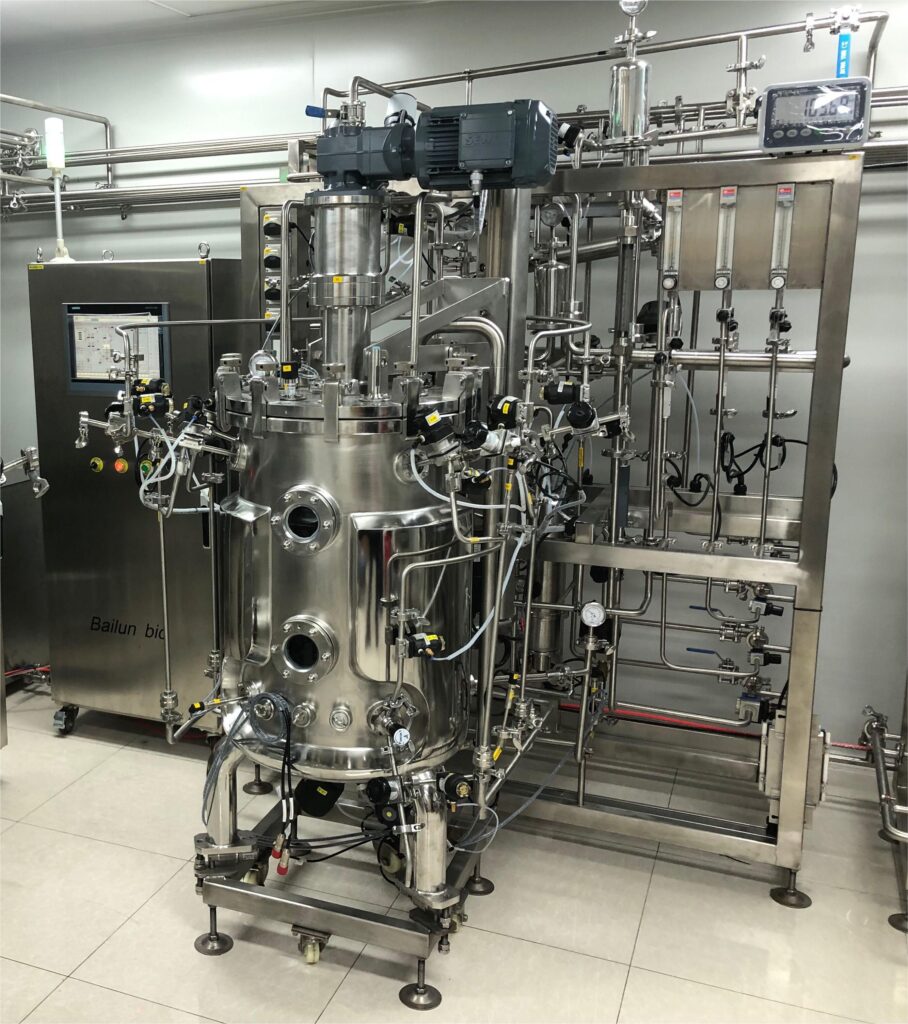
Advantages and limitations
Stainless steel bioreactors have many advantages, but also some limitations. The following are the main advantages and limitations of stainless steel bioreactors:
Advantages:
(1) Corrosion resistance: Stainless steel bioreactors are made of stainless steel materials and have good corrosion resistance. They can resist the erosion of acids, alkalis, oxidants and other substances, thereby maintaining the long service life of the reactor.
(2) High strength: Stainless steel bioreactors have high strength and rigidity and can withstand working under extreme conditions such as high pressure and high temperature, ensuring the safety and reliability of the reaction process.
(3) Easy to clean: Stainless steel bioreactors have smooth surfaces and are not easy to adhere to microorganisms, contaminants, etc., making cleaning and disinfection more convenient and quick, helping to maintain the hygiene of the reactor and prevent cross contamination.
(4) Controllability: Stainless steel bioreactors are equipped with a complete control system that can accurately adjust important parameters such as temperature, pressure, pH value, dissolved oxygen content, etc. inside the reactor to achieve precise control and optimization of the reaction process.
(5) Scalability: Stainless steel bioreactors can be expanded in scale as needed and are suitable for applications of different scales such as laboratories, pilot plants and industrial production. They have certain production flexibility and adaptability.
Limitations:
(1) High initial investment cost: Compared with reactors made of other materials, the initial investment cost of stainless steel bioreactors is higher, mainly due to the high cost of materials and manufacturing processes.
(2) High quality control and purity requirements: In some applications, such as pharmaceutical production, stainless steel bioreactors have high requirements for product quality and purity, so there are higher requirements for reactor material selection, process control, cleaning and disinfection.
(3) Low heat transfer efficiency: The heat transfer efficiency of stainless steel bioreactors is relatively low, and longer heating or cooling times may be required, increasing the time and energy consumption of the reaction process.
(4) Operability limitations: Due to the structural and material limitations of stainless steel bioreactors, some special or complex operations, such as high shear force and high gas flux, may be subject to certain restrictions in practice.
Stainless steel bioreactors have many advantages, such as corrosion resistance, high strength, easy cleaning and controllability. However, it also has some limitations, such as high initial investment cost, high quality control and purity requirements. Therefore, when selecting and applying stainless steel bioreactors, it is necessary to comprehensively consider the actual needs and the limitations faced.
Applications
Stainless steel bioreactors are widely used in the field of bioengineering. The following are some of the main application areas:
(1) Biopharmaceuticals: Stainless steel bioreactors are often used to produce pharmaceutical products, such as antibodies, vaccines, growth factors, etc. They can provide a stable growth environment and appropriate temperature, pH value and oxygen supply to support the growth of microorganisms or cells and product synthesis.
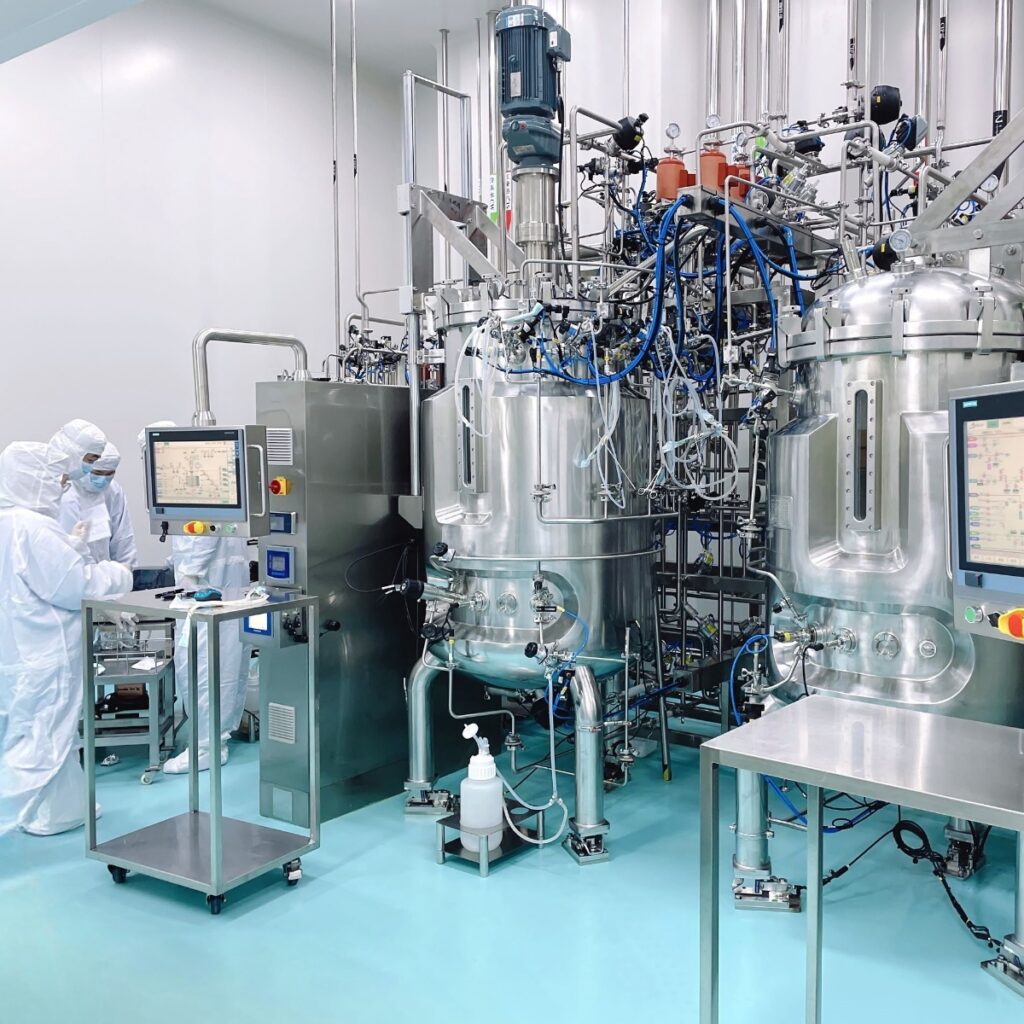
(2) Food industry: Stainless steel fermenters are used in fermentation processes in the food industry, such as the production of bread, alcohol, yogurt, soy sauce, etc. By controlling the reaction conditions and the selection of microorganisms, the fermentation process can be optimized and the quality and yield of the product can be improved.
(3) Bioenergy: Stainless steel fermenters are used in the production of biomass energy, such as bioethanol and biodiesel. Through fermentation or the action of microbial enzymes, biomass can be converted into renewable energy to replace traditional petroleum energy.
(4) Environmental protection: Stainless steel fermenters are also used in the environmental field, such as wastewater treatment and soil remediation. By utilizing the metabolic capacity of microorganisms, organic pollutants can be degraded or harmful substances such as heavy metals in sewage can be removed.
(5) Scientific research: It’s also widely used in biological research, such as cell culture, protein expression and purification. By regulating the conditions and parameters inside the reactor, we can deeply study biological processes and biological functions and promote the development of science.
Stainless steel bioreactors are widely used in the field of bioengineering and can be used in the production of pharmaceutical products, food fermentation, bioenergy, environmental protection and scientific research. With the continuous development of biotechnology, the application field of stainless steel bioreactors will continue to expand and deepen.
Development Trends
As a key bioengineering equipment, stainless steel fermenters will be affected by the following trends in their future development:
(1) Automation and intelligence: With the rapid development of automation and artificial intelligence technologies, stainless steel bioreactors will become more intelligent and automated. For example, through real-time monitoring and control systems, real-time monitoring and precise control of the reaction process can be achieved, improving the efficiency and consistency of biological reactions.
(2) Flexible production: In the future, stainless steel bioreactors will be more flexible and adaptable to changing needs. Flexible production technology will provide the ability to quickly switch and adjust according to the needs of different products, thereby improving production efficiency and product diversity.
(3) Miniaturization and greening: The development of microfluidic technology and microbial reactors will drive stainless steel bioreactors towards miniaturization. Microreactors can provide a larger surface area to volume ratio, improve mass transfer efficiency and reaction rate. In addition, greening requirements will promote improvements in stainless steel bioreactors in terms of energy utilization and environmental friendliness.
(4) New materials and new processes: The research and development and application of new materials will promote the development of stainless steel bioreactors. For example, the application of nanomaterials, functional coatings and composite materials can improve the corrosion resistance and mass transfer performance of stainless steel reactors. At the same time, new manufacturing processes such as 3D printing technology are also expected to improve the manufacturing accuracy and customization of reactors.
(5) Networking and data analysis: The development of Internet of Things technology will enable stainless steel bioreactors to be remotely monitored and managed, thereby improving production efficiency and traceability. In addition, through the application of big data and data analysis, a deeper understanding and optimization of the reaction process can be achieved, promoting the further development of reactor technology.
These trends will promote the application of stainless steel bioreactors in the field of bioengineering to be more efficient, sustainable and intelligent.

